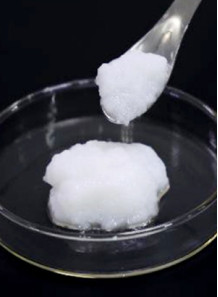Nanocellulose Fibril (D50=100-150micron, L=100-1000micron, W=0.2-20micron, 2.5%-3.5%)
- Product Code: 31494
Shape: Fibril, D50 (micron): 100-150
Length: 100-1000micron
Width: 0.2-20micron
Concentration 2.5-3.5%
- -
- -
- -
- -
- -
- -
- -
- -
- -
- -
- -
- -
- -
- -
- -
- -
- -
- -
| Test Name | Specification |
|---|---|
| Appearance | White suspension liquid |
| Content (%) | 3.0 |
| Particle Size | 80-100 |
| pH Value | 5-7 |
Nanocellulose Fiber Nanocellulose is cellulose material with nano size It has special properties in various fields that are useful in food and cosmetics.
Application in food:
Texture enhancer and stabilizer: Nanocellulose can be used as a natural texture and stabilizer in food products. It can help improve the texture, viscosity and consistency of sauces, salad dressings and other liquid foods.
Fat replacement and calorie reduction: Same as microcrystalline cellulose. Nanocellulose can serve as a fat substitute in low-fat or low-calorie diets. It can help maintain the desired mouthfeel and texture while reducing the overall fat content of the product.
Film Coating: Films and coatings made from nanocellulose can be applied to fruits and vegetables to extend their shelf life by creating a barrier against moisture and gases.
Application in cosmetics:
Emulsion stabilization: Nanocellulose can stabilize emulsions in cosmetic products. Helps prevent separation of water and oily ingredients. This is useful in products such as creams, lotions and serums.
Thickeners and texture thickeners: Nanocellulose can act as a thickener to improve the texture and consistency of cosmetic formulations. It can give a soft and luxurious feel to products such as moisturizers and body creams.
Delivery of active ingredients: Cellulose nanoparticles can encapsulate and deliver active ingredients to the skin. Increase efficiency and deliver on target. This is especially useful in products such as serums and treatments.
Sunscreen formulations: Nanocellulose can be used to improve the dispersion of sunscreens in cosmetic products. This leads to more consistent and effective sun protection.
Use: emulsion stabilizer
How to mix: Blend or stir until dissolved in water.
Utilization rate: 0.1-2%
Product characteristics: white cream
Solubility: can be dispersed in water
Storage: can be stored at room temperature But close the bottle cap tightly. Then completely covered from sunlight or heat, the product is at least 2 years old.
INCI Name : Cellulose
Be the first to review this product :-)
Recommend Lab-Service
| Lab Service | Price |
|---|
Shape: Fibril, D50 (micron): 100-150
Length: 100-1000micron
Width: 0.2-20micron
Concentration 2.5-3.5%
Nanocellulose Fiber Nanocellulose is cellulose material with nano size It has special properties in various fields that are useful in food and cosmetics.
Application in food:
Texture enhancer and stabilizer: Nanocellulose can be used as a natural texture and stabilizer in food products. It can help improve the texture, viscosity and consistency of sauces, salad dressings and other liquid foods.
Fat replacement and calorie reduction: Same as microcrystalline cellulose. Nanocellulose can serve as a fat substitute in low-fat or low-calorie diets. It can help maintain the desired mouthfeel and texture while reducing the overall fat content of the product.
Film Coating: Films and coatings made from nanocellulose can be applied to fruits and vegetables to extend their shelf life by creating a barrier against moisture and gases.
Application in cosmetics:
Emulsion stabilization: Nanocellulose can stabilize emulsions in cosmetic products. Helps prevent separation of water and oily ingredients. This is useful in products such as creams, lotions and serums.
Thickeners and texture thickeners: Nanocellulose can act as a thickener to improve the texture and consistency of cosmetic formulations. It can give a soft and luxurious feel to products such as moisturizers and body creams.
Delivery of active ingredients: Cellulose nanoparticles can encapsulate and deliver active ingredients to the skin. Increase efficiency and deliver on target. This is especially useful in products such as serums and treatments.
Sunscreen formulations: Nanocellulose can be used to improve the dispersion of sunscreens in cosmetic products. This leads to more consistent and effective sun protection.
Use: emulsion stabilizer
How to mix: Blend or stir until dissolved in water.
Utilization rate: 0.1-2%
Product characteristics: white cream
Solubility: can be dispersed in water
Storage: can be stored at room temperature But close the bottle cap tightly. Then completely covered from sunlight or heat, the product is at least 2 years old.
INCI Name : Cellulose
| Mechanism | - |
| Appearance | - |
| Longevity | - |
| Strength | - |
| Storage | - |
| Shelf Life | - |
| Allergen(s) | - |
| Dosage (Range) | - |
| Recommended Dosage | - |
| Dosage (Per Day) | - |
| Recommended Dosage (Per Day) | - |
| Mix Method | - |
| Heat Resistance | - |
| Stable in pH range | - |
| Solubility | - |
| Product Types | - |
| INCI | - |
Cart
No products



